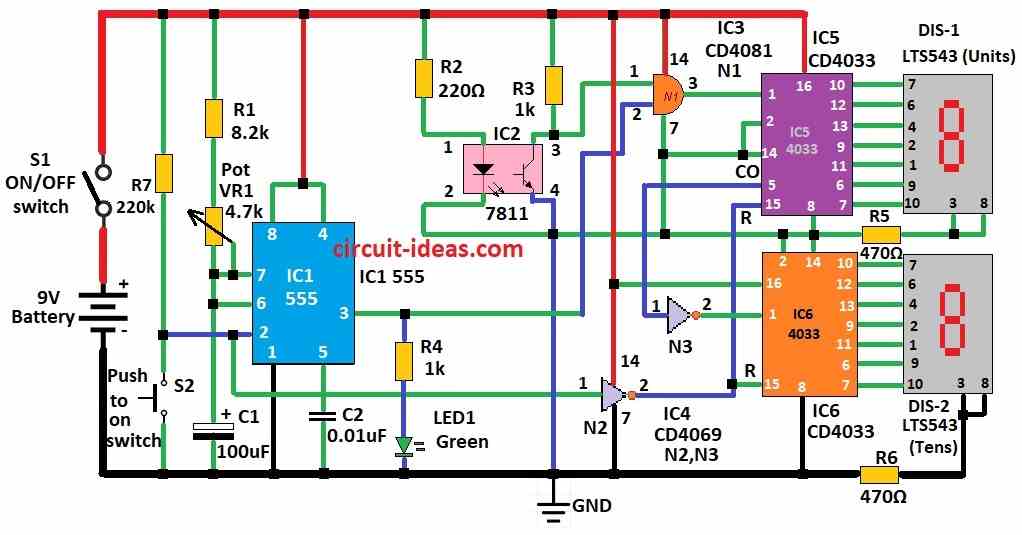This easy to build Tachometer Circuit is a small DIY tool to check speed of rotating shaft or disc.
We use tachometer to know how fast shaft or wheel spin in RPS (revolutions per second).
This simple circuit uses two 7-segment displays and one slotted opto sensor MOC7811 where all parts are easy to find.
With this circuit we can measure RPS of rotating shaft or disc.
If add one more counter stage it can count from 00 to 99 RPS.
What is a Sensor IC MOC7811?
IC MOC7811 is opto slotted coupler it is also called opto interrupter.
It is useful tool in electronics and communication.
It has two parts: one infrared LED (IRED) and one phototransistor which together they work strong.
Its smart design help to detect object or block in light path.
So IC MOC7811 is flexible and popular.
People use it for object sensing, position check and rotation count.
Circuit Working:

Parts List:
| Category | Description | Quantity |
|---|---|---|
| Resistors (All resistors are 1/4 watt unless specified) | 8.2k | 1 |
| 220Ω | 1 | |
| 220k | 1 | |
| 1k | 2 | |
| 470Ω | 2 | |
| Potentiometer 4.7k | 1 | |
| Capacitors | Ceramic 0.01μF | 1 |
| Electrolytic 100μF 25V | 1 | |
| Semiconductors | IC1 555 | 1 |
| IC2 7811 | 1 | |
| IC3 CD4081 | 1 | |
| IC4 CD4069 | 1 | |
| IC5 CD4033 | 1 | |
| IC6 CD4033 | 1 | |
| Displays 7 segment common cathode | 2 | |
| LED1 green 5mm 20mA | 1 | |
| ON/OFF switch | 1 | |
| Push to ON switch | 1 | |
| 9V Battery | 1 |
This circuit uses many ICs to make tachometer for measuring RPS (rotations per second).
Working parts:
IC 555:
Works like monostable timer.
When press switch S2 it gives time pulse.
LED1 green shows this timing.
MOC7811 IC2:
Has IR emitter and photodiode.
Photodiode change signal when IR light is blocked.
AND Gate N1:
This gate control the CD 4033 counter.
CD 4033:
It is decade counter and it sends signal to 7-segment display LTS543 to show RPS.
This design can show RPS from 00 to 99.
Two decade counters and displays image:

Information also tell us how to make rotating interrupter.
It says to measure slot size of MOC7811 and shaft nose size carefully.
When shaft nose block IR light then it count as one rotation.
Total counts during sensing time give RPS.
To get RPM it just multiply RPS by 60.
Formulas:
With ICs and parts listed we can make tachometer to check speed (RPM) of spinning thing like motor or engine.
It show RPM on 7-segment display.
Important Points:
Convert Frequency to RPM:
Use formula:
RPM = f × 60 / PPR
where:
- f is the frequency pulses per second
- PPR is the pulses per one full turn of revolution from sensor
IC 555 as Monostable:
IC 555 make one-time pulse when trigger signal comes which is called one-shot pulse.
Pulse Time T:
Pulse time is set by R1 and C1:
T = 1.1 × R1 × C1
where:
- T is the time in seconds
- R1 is the resistance in ohms Ω
- C1 is the capacitor in farads F
By using these steps and changing values as needed we can build tachometer for our project.
Safety Measure:
- Check all wire and parts before turning ON.
- Follow circuit diagram correctly.
- Be sure shaft and interrupter are fixed tight so they do not fall off or cause danger.
- When circuit is running keep hands and things away from moving parts.
- If using for long time better to put circuit in safe box to stop an accident.
Conclusion:
With this Tachometer Circuit we can make tachometer to measure spin speed using easy parts.
Making this can be fun for electronics hobby.
But if we need more features or special output then circuit can get more difficult.
Leave a Reply